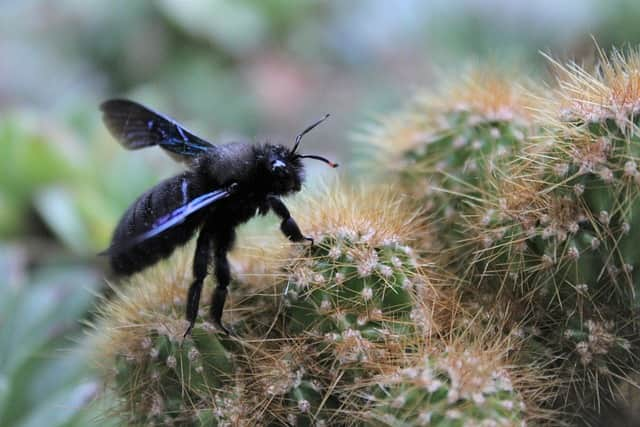Do Carpenter Bees Sting?
They are interesting insects that are generally not aggressive towards humans and usually make nests by carving wood. These bees belong to the subfamily Xylocopinae of the order Hymenoptera.
They are big and strong. Their bodies can often have black, blue, green or metallic colors. Their large, powerful jaws are adapted for carving wood.
They make nests by carving wood. They generally prefer rotten or soft wood. Females lay eggs in the cavities they dig, and their larvae grow in these cavities.
They are generally solitary insects. Females build their own nests and feed their own larvae. However, in some species females have been observed sharing nests.
Male carpenter bees are generally larger than females and may be yellow in color. Females, on the other hand, are generally larger, more colorful and have long antennae that they use when carving wood.
They clean rotten wooden materials by carving wood. This helps maintain balance in the ecosystem and accelerates the decomposition of rotten wood, releasing nutrients.
They are interesting insects that play a unique role in nature and contribute to the healthy functioning of ecosystems. Although they are generally harmless to humans, it is important that their nests are not interfered with and their natural habitats are protected.

What Will We Learn?
Do Carpenter Bees Sting?
No, carpenter bees are generally not aggressive to humans and do not tend to sting. However, female carpenter bees make nests by carving wood. Male carpenter bees are generally no more aggressive than females, and they are also not capable of stinging because they do not have a stinging organ.
Female carpenter bees carve wood, so they can damage the wooden structures of the house or furniture. However, they do not attack humans and generally do not tend to sting for self-defense. If you are bothered by carpenter bees, you can get help from an expert pest control specialist.
Do Carpenter Bees Eat Wood?
Yes, carpenter bees are known for their ability to carve wood. Females mostly prefer soft or rotten wood to lay their eggs and raise their larvae. Carpenter bees drill holes in wood structures such as tree stumps, wooden fences, and ceiling laths to build their own nests.
Carpenter bees drill into the surface of the wood using their jaws and teeth and then rotate their bodies to enlarge the cavity. These cavities can generally be in the form of horizontal or vertical galleries. Females lay eggs in these hollowed-out cavities and their larvae grow in these cavities.
This behavior is a feature that justifies the term “carpenter”, from which carpenter bees derive their name. Although they mostly prefer rotten wood or soft wood, they can occasionally attract people’s attention because they can damage building materials.
Are Carpenter Bees Pollinators?
Yes, carpenter bees play a pollinator role. While they collect nectar from flowers, they also carry pollen. Females fulfill their pollination function by depositing the pollen they carry on their bodies into the pistils of these flowers as they move on to other flowers.
This is a vital process for plant reproduction because most plants produce seeds when pollination occurs by transferring pollen to other flowers. Pollination is important for maintaining plant diversity and producing fruits and seeds of many plants.
They often perform pollination duties together with other bee species and insects. This contributes to the healthy functioning of ecosystems and plant communities in nature.
How Can I Try to Control Carpenter Bees?
If you are bothered by carpenter bees or if they are causing damage in your home or garden, there are a few suggestions.
They make nests by drilling holes in wood. You can block the entrances to these holes by using materials such as wire mesh or cast wax, thus preventing the formation of new nests.
They generally prefer soft or rotten wood. You can make wooden surfaces more durable by regularly maintaining or painting them.
Chemical interventions against carpenter bees include the use of an appropriate insecticide. However, caution must be exercised in this type of intervention, as chemicals can harm other bees and the environment. Seeking help from a professional pest control expert is often a safer option.
When dealing with carpenter bees, it may be best to seek help from a professional pest control service, especially if the problem is large or you are having difficulty controlling it. Experts can offer effective and environmentally friendly solutions.
You can use natural materials to deter carpenter bees. For example, applying natural essential oils such as peppermint oil, tea tree oil, or lavender oil to wood surfaces can keep carpenter bees away.
The method to be used to combat carpenter bees may vary depending on the extent of the problem, local regulations and environmental impacts. Therefore, it is important to consult local regulations and expert advice before seeking professional help.
Our article titled “Do lady bugs bite” may also attract your attention.
